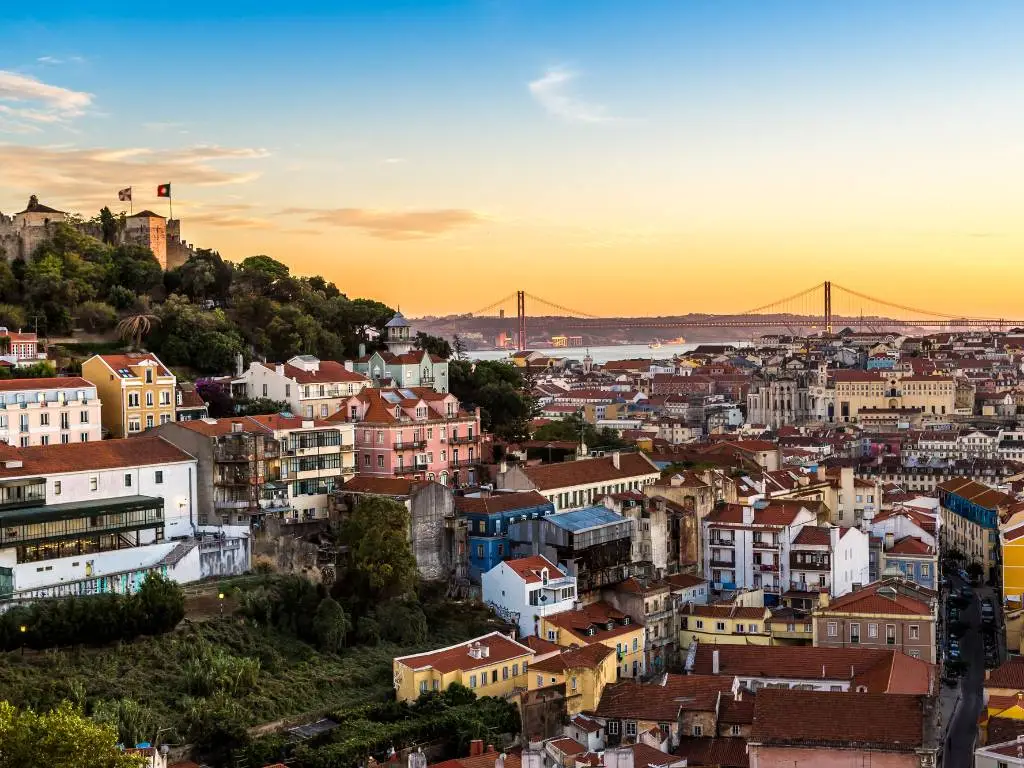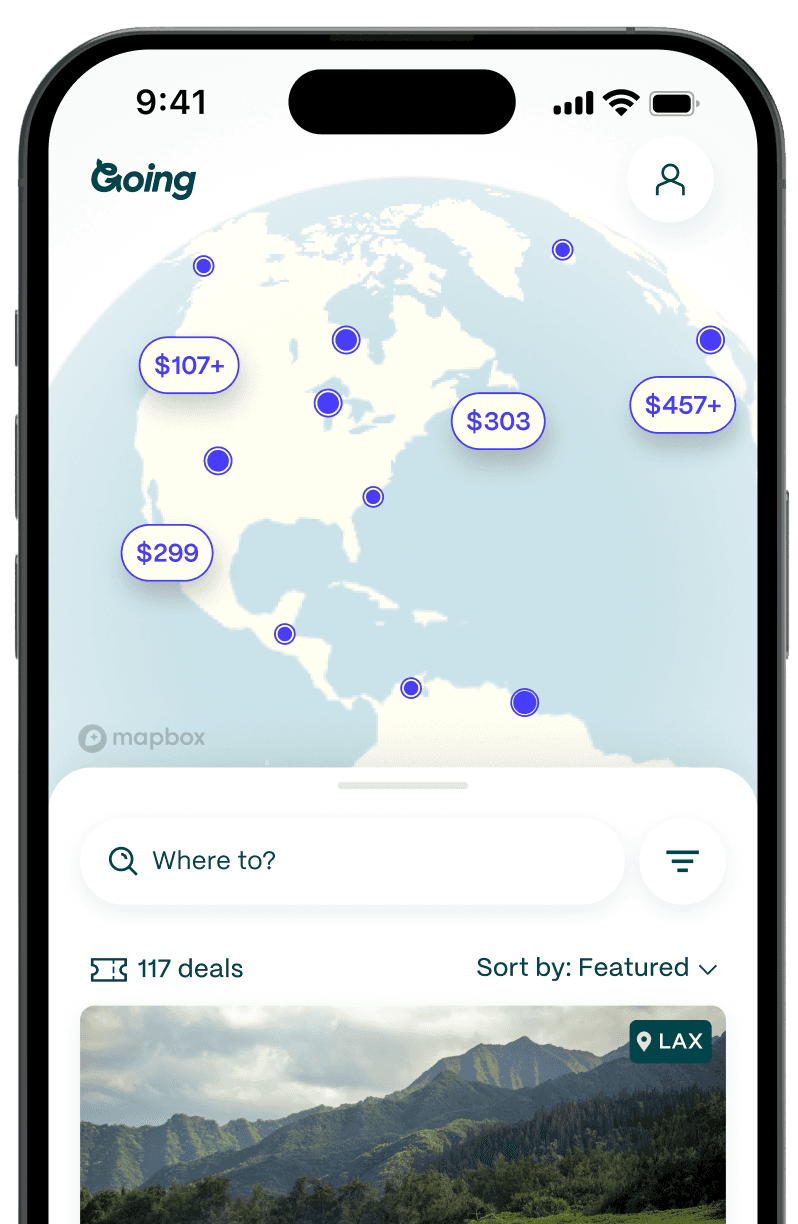
Lisbon: The Seaside City That’s the Second-Oldest Capital in Europe
One of Europe’s oldest and most colorful cities, Lisbon’s layout is as winding and varied as its storied past—which dates all the way back to 1200 BCE. Rocked by one of the most destructive earthquakes the world has ever seen, today Portugal’s capital shines with beauty in every tiled building and romantic palace. It’s a city of sprawling vistas, steep hills, and climbing cable cars, where the night air is filled with the beautiful music of heartbreak and the salt of the Tagus River and Atlantic Ocean.

Portuguese 101
If you think speaking Spanish will help you with your Portuguese, think again. In Lisbon, you’ll find that most people speak some English, but having a little Portuguese in your pocket will always be appreciated. The two letters that trip up most foreigners in Portugal are j and r. Unlike Spanish where the j takes on an h sound, words that begin with j in Portuguese are pronounced just like a j in English, except a little softer. On the other hand, r is pronounced with an h sound—but only when it is at the beginning of a word.
The word “thank you” can also cause a lot of confusion since both “obrigado” and “obrigada” are used simultaneously. However, whether you use “a” or “o” as an ending is simply a matter of what gender you identify as (obrigada is used by females, and obrigado is used by males). Non-binary Portuguese speakers may sometimes use “obrigade” as an alternative, but the masculine form may also be considered gender-neutral.
The earthquake that shaped the city

In 1755, Lisbon (and the surrounding area) was a site of a disaster so destructive that it fundamentally changed the character of the city. On All Saints Day, November 1, an estimated 8.5 earthquake hit, followed by a tsunami that washed out downtown Lisbon. Simultaneously all over the city, candles that had been lit for the religious holiday toppled over, starting a fire that burned for five days.
The city center had to be completely rebuilt, but you can get a sense of what pre-earthquake Lisbon was like by wandering through Alfama. One of the neighborhoods least damaged by the ‘quake, its narrow streets and winding staircases paint a more medieval picture of Lisbon’s once-labyrinthine streets. On the third floor of the Museu Nacional do Azulejo, you can also find an impressive panorama depicting the former cityscape on blue and white tiles.
Sipping ginjinha
A sweet beginning, middle, or end to any night out in Lisbon, ginjinha (or ginja for short) is a liqueur made from sour cherries. If you just want a quick taste, you can find tourist-geared shops surrounding Praça do Comercio and Rossio, but it’s also served in local bars and cafes all over the city. The history of the drink in Lisbon is a bit murky, but it's been around since at least 1840, when the city’s oldest ginjinha bar, A Ginjinha Espinheira, opened.
Martim Moniz is a great neighborhood to take yourself out on a personal tasting tour, starting with the close-quarters Os Amigos da Severa, where the owner sells ginjinha made from his personal recipe. From here, you can make your way toward the Escadinhas de Sao Cristóvão, while popping into any local ginjinha bar that catches your eye. Once you reach the stairwell, enjoy another taste of ginjinha from Boutique Taberna and drink it out on the steps covered in fado-themed street murals.
Connect with nature in Cascais and Sintra

In about an hour by train, you can visit two nearby cities where the Portuguese royalty and Lisbon’s upper classes built their mountaintop palaces and seaside mansions. During the age of romanticism, it was here where the upper classes found fresh air and an escape to nature—and today they are the best spots to work some exercise into your sightseeing.
Rent a bike in Cascais and explore the 5.5-mile (one-way) bike trail that follows the coastline to the large Guincho Beach. In Sintra, take the long way to visit Pena Palace by following the hiking trail that starts in Vila Sassetti. The uphill trail takes about an hour and brings you past the Moorish Castle and up to the gates of the palace. It’s worth going inside to see the remarkable view of Lisbon and the sea from the royal bedroom.
Mark the map for miradouros
The hilly city is spotted with more than two dozen viewpoints known as miradouros. Each viewpoint offers a unique perspective on the city and is like a small park. It’s worth asking locals for their favorite viewpoint, but you’ll find that everyone has a different opinion based on both the views and the vibes.
Above Alfama, Santa Luzia is a stunning miradouro with a flower-covered pergola and a garden decorated with large azulejo panels, a distinctly Portuguese style of ceramic tile mosaic. During sunset hours, it can be hard to nab a seat, so get there early. From here, you can walk up to Castelo São Jorge to appreciate high-altitude views (with the cost of admission), but you’ll get the best view of the castle at Miradouro da Senhora do Monte, just 15 minutes away.
Feeling the saudade in fado

Saudade is a uniquely Portuguese word that is best summarized in the emotional depths of fado, a musical style characterized by its melancholic and longing melodies and themes of nostalgia and heartbreak. The exact origins of fado are unknown, but its history can be traced back to Lisbon’s Alfama district during the early 19th century when it was home to working-class sailors and fishermen. You can see for yourself that it is still a proud tradition of this neighborhood today—just follow the sounds of live performers echoing through the squares.
For a more intimate experience, you can pay and go to Alfama’s iconic fado bars like Tasca do Chico. If you’re short on time, consider Tasca do Jaime for an afternoon show. It’s common to eat during the performance at these locations, but talking over the song may earn you some sharp glares. If the vulnerability of fado’s soulfulness strikes a chord with you, you can learn more while listening to the recordings of the genre’s iconic performers at the Fado Museum.
Fruits of the sea
Every time you go out for seafood—or frutos do mar—in Lisbon, you have an opportunity to taste Portugal’s rich seafaring and trading history. The Portuguese capital is the perfect place to try the seafood specialties from regions across Portugal, like the cataplana, a fish stew from the Algarve, and percebes, a type of barnacle that is harvested by fishermen braving dangerous conditions between sharp rocks and a tumultuous sea.
Bacalhau, the Portuguese term for salted codfish, is the most iconic ingredient in all of Portugal’s cuisine with thousands of ways to prepare it, but don’t go around asking where you can try it fresh. The cod is not actually from Portugal but instead caught in northern European waters and then preserved in salt. Rivaling bacalhau, sardines may be the most beloved fish in all of Portugal. They’re sold all over the city in decorative collectible tins.
One pastry to rule them all

The pastel de nata is Lisbon’s most ubiquitous pastry and sold anywhere you can buy an espresso. The flaky crust is filled with a creamy egg custard that is brûléed and dusted with cinnamon. It’s the kind of pastry you’ll spend your days dreaming about, long after you’ve left Lisbon, especially if you make the trip to Belém to try the original recipe.
This famous pastry was invented by monks at Jerónimos Monastery with too many leftover egg yolks. They were first sold down the street from the monastery at Pastéis de Belém, which opened in 1837. For almost two centuries, this pastry shop has been churning out thousands of tarts a day—all according to the original recipe which is kept under lock and key.
Mosaic ain’t so

It’s difficult to overstate the beauty of Portuguese tiles, which are used all over Lisbon from the grand murals inside churches and palaces to the decorative touches that brighten up the city’s nooks and crannies. Known as azulejos, these tiles were used to both insulate and beautify Portuguese architecture, and they make one of the best distinctly Portuguese souvenirs.
There are many places where you can buy authentic azulejo tiles, whether you’re looking for something custom-made or antiques. Family-run Cortiço & Netos in Arroios was founded by the late Joaquim José Cortiço who collected discontinued ceramic tiles from Portuguese factories, some of which have since closed. Now run by his grandkids, the shop offers tiles from the '60s onward. You can also visit antique shops like Solar Antiques, the world’s largest antique tile store. And in Belèm, you can get a tile-painting demonstration with your shopping at the Fábrica Sant’Anna tile factory. (Note that some places—like stalls at the flea market—do not source their tiles ethically, pulling them straight from building facades, so always ask where they come from.)
At the river’s mouth
At the end of the Tagus River’s long journey from the Spanish mountains, Lisbon is both a riverside and seaside city and there are many ways to experience its beautiful cityscape from the water. Sunset and sailing cruises are popular, but a more budget-friendly option is to take the ferry across the river to Cacilhas where you’ll find a strip of restaurants and docks that offer another view of the city.
If you’re prone to seasickness, you can still enjoy the water by venturing away from the historic center to the more modern Parque das Nações area. Kayaks and other small boats can be rented from the marina, or you can enjoy the water from dry land by strolling along the boardwalk or taking to the sky for a cable car ride. In this area, you’ll also be right next to the Lisbon Oceanarium, one of Europe’s largest and most impressive aquariums.
Good to Know
Is Lisbon expensive?
As far as Western European cities go, Lisbon is relatively inexpensive; however, as it becomes more and more of a tourist hotspot, prices go up. You can expect to spend $70–$150 per night on accommodations (or as low as $35 per night if you’re traveling on a budget and staying in hostels). Lunch runs $8–$10 at cafés, while dinner at a restaurant can cost anywhere from $25–$50 including a glass of wine or beer—though it is definitely possible to spend less on food and drink if you’re savvy. Entrance fees to common tourist attractions run anywhere from $5–$25, so how much you spend on extracurriculars depends entirely on how many attractions you’re planning to hit.
Best time to visit Lisbon
There is truly not a bad time to visit Lisbon. Summer (June–August) is the busiest tourist season by far, which also means you’ll run into more people and experience higher rates. Spring and fall—although there is the occasional rain shower—can be just as warm and enjoyable; you’ll save a lot of money on accommodations and avoid the big crowds. The Popular Saints’ festivities (Santos Populares), which take place in June, are the biggest celebration in Lisbon.
What languages are spoken in Lisbon
While Portuguese is the main language in Lisbon, English is widely spoken throughout the capital, particularly by those working in the tourism and service industries. The signage on public transport and at major attractions, like museums, is typically displayed in both Portuguese and English.
Lisbon with kids
Lisbon is a very family-oriented city, with plenty of kid-friendly activities within the capital and just outside of it, including an oceanarium, zoo, trams, and nearby beaches. Note that the city is incredibly hilly, which may not be as accessible for parents of small children.
Lisbon public transportation
Lisbon is a very walkable city, but when walking won’t do, there are plenty of public transport options: The metro, trams, and funiculars are all quick, easy (and often scenic) ways to get around the city. You can also get out of the city easily with Lisbon’s train and ferry network.
Is Lisbon safe?
Portugal ranks #7 out of 163, according to the Global Peace Index. Lisbon is generally considered a very safe city. As with any major city, be aware of petty crime, like pickpocketing, in crowded areas.
Portugal ranks #35 in the world for LGBTQ+ equality, with a score of 69/100. Lisbon itself is considered an LGBTQ+-friendly city. The Príncipe Real neighborhood is the heart of Lisbon’s gay scene, with plenty of welcoming bars and clubs. Every September, Lisbon also hosts Queer Lisboa, the only Portuguese film festival solely dedicated to LGBTQ+ films (the fest then heads to Porto in October).
Money saving tips
Skip the taxis. They aren’t cheap in Lisbon and you generally don’t need to take one when trams, buses, bikes, and your own two feet work just as well.
Try the menu of the day. This set menu, usually three courses, offers a great value for lunch or dinner.
Many of the city’s major museums offer free admission on certain days of the month, or discounted admission to students and seniors. Be sure to check out the museum's pricing guide before booking tickets.
How to get to Lisbon from Humberto Delgado Airport (LIS)
Lisbon Airport has its own Metro station on the city’s subway network. It’s the terminus of the Aeroporto – Saldanha line, otherwise known as the red line. A single journey ticket costs €1.65 (plus an additional €0.50 for a rechargeable card), and a day pass costs €6.60. Travel time from the airport to downtown Lisbon is about 20 minutes. The city’s bus system also stops at the airport, but there’s a maximum baggage size allowed—so if your luggage is bigger than 55x40x20cm you won’t be able to take the city bus. A taxi ride to downtown takes 30 minutes or less with fares around €20. Uber rates to the city center start at about €10.
What to see, do, and eat in Lisbon from Going
The top 10 things to do in Lisbon
- Ride one of the city’s classic funiculars, elevators that whisk you up some of the steeper streets
- Visit St. George’s Castle, or Castelo de S. Jorge, which overlooks the city
- Marvel at the stunning Gothic-style building, Jerónimos Monastery, in Belém
- Shop and people watch at the Mercado da Ribeira
- Grab some seaside seafood in Cascais
- Venture out to Praia da Sereia for a beach day
- Catch a glimpse of the iconic Torre de Belém, a 15th century tower
- Spend a day at the National Museum of Ancient Art
- Explore the beautiful gardens at the Palace of Marquises of Fronteira
- Check out the open-air market known as Feira da Ladra, full of unique antiques and souvenirs
Local picks for top attractions and activities in Lisbon
- Visit the José Saramago Foundation, a museum dedicated to one of Portugal’s greatest writers; read his incredible novel, Blindness, ahead of your visit
- Head down to the LX Factory, a former industrial area turned cultural center, for everything from tacos and tattoos to vintage shops and art studios
- Go to Ler Devagar to explore one of the world’s most beautiful bookshops
- Check out the gorgeous MAAT, a contemporary art museum that sits along the shore of the Tagus River
- Take a picnic to Monsanto Park
- Take a trip to Jardim da Cerca da Graça, a lovely hillside garden with city views and an onsite cafe
- Browse the shelves of A Vida Portuguesa, a beautifully curated boutique that celebrates authentic, enduring products used throughout Portugal
- Spend a day at Praia de Carcavelos, which has earned a Blue Flag for its water quality and safety standards
- Visit the family-friendly Jamor Adventure Park
- Take a kayak tour on the open seas
What to eat and drink in Lisbon
Seafood, in its myriad forms, is king here, and it should be eaten as frequently as possible for maximum vacation bliss. Seaside dining is plentiful, too, so don’t miss your chance to indulge in many waterfront meals. There’s also a formidable array of world-class chefs with unique restaurants in Lisbon to satisfy any foodie, but eating traditional Portuguese food is a divine experience (see also: excellent canned fish you can take home, and legendary pastries unlike any you’ve ever tried before).
- Taberna do Calhau offers authentic Alentejano cuisine in a small and charming restaurant that’s great for a low-key date night
- Any restaurant in the José Avillez group is great; the group is world-renowned for their contemporary Portuguese cuisine and energetic environs that champion the element of surprise
- Manteigaria is a specialized shop that turns out decadent pastel de nata pastry by the dozen
- Pink Street is a bubblegum corridor that’s known for nightlife, but it’s best enjoyed midday for a drink and some gourmet canned fish at an outdoor table at Sol e Pesca
- Foxtrot is a dark, inviting Art Deco cellar bar with a lively vibe, inventive cocktails, and tasty, old-world pub fare
- Tasca do Chico is a tiny hole-in-the-wall spot where locals belt out mournful ballads that epitomize the Portuguese spirit of saudade
- Dois Corvos is a slightly out-of-the-way brewery that’s worth the trip and is at the forefront of Portugal’s craft beer scene
- Ginjinha Sem Rival is a tiny family-owned shop that’s been here for almost 200 years; if you’re feeling adventurous, grab a glass of Eduardino, a mixture of ginjinha and anise liqueur
See Going's deals on flights to Lisbon, and join today to get cheap flights delivered right to your inbox.
Read about more destinations in Europe:
Last updated August 16, 2024









